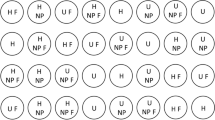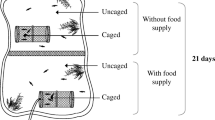Abstract
The hypothalamic–pituitary–adrenal/interrenal (HPA/I) axis plays a key role in responding to biotic and abiotic challenges in all vertebrates. Recent studies have shown that the apical response of the HPI axis to stressors in three-spined sticklebacks varies in proportion to the concentration of wastewater treatment works (WWTW) effluent to which the fish are exposed. This study was conducted to determine whether between-site variation in stress responsiveness among WWTW effluent-exposed sticklebacks is persistent or reversible. Sticklebacks from eight sites in north-west England affected by WWTW effluent and exhibiting between-population variation in HPI axis reactivity, were moved to a clean-water aquarium environment. After five months in the contaminant-free environment the responsiveness of these fish to a standardised stressor was determined, by measuring the rate of stress-induced cortisol release across the gills, and compared with the responses of fish newly sampled from the eight original capture sites. Inter-site differences in the reactivity of the HPI axis, proportional to the effluent concentration at each site, persisted among the translocated female sticklebacks for at least 5 months. In male fish however, the direct relationship between stress responsiveness and site-specific effluent was not evident 5 months post-translocation. These results support previous observations that the HPA/I axis, a non-reproductive endocrine system, is vulnerable to modulation by anthropogenic factors in fish and show for the first time that, in female fish at least, this modulation is not transient. The mechanisms underlying these observations, and the implications for the fitness and resilience of affected populations, requires investigation.




Similar content being viewed by others
References
Aluru N, Vijayan MM (2006) Aryl hydrocarbon receptor activation impairs cortisol response to stress in rainbow trout by disrupting the rate-limiting steps in steroidogenesis. Endocrinology 147:1895–1903
Aluru N, Renaud R, Leatherland JF, Vijayan MM (2005) Ah receptor-mediated impairment of interrenal steroidogenesis involves StAR protein and P450scc gene attenuation in rainbow trout. Toxicol Sci 84:260–269
Barton BA (2002) Stress in fishes: a diversity of responses with particular reference to changes in circulating corticosteroids. Integr Comp Biol 42:517–525
Beardsley H, Britton JR (2012) Contribution of temperature and nutrient loading to growth rate variation of three cyprinid fishes in a lowland river. Aquat Ecol 46:143–152
Bélanger-Deschênes S, Couture SP, Campbell PGC, Bernatchez L (2013) Evolutionary change driven by metal exposure as revealed by coding SNP genome scan in wild yellow perch (Perca flavescens). Ecotoxicology 22:938–957
Bergman Å, Heindel JJ, Jobling S, Kidd KA, Zoeller RT (eds) (2013) State of the science of endocrine disrupting chemicals 2012; United Nations Environment Programme and World Health Organization: Geneva, 2013. http://www.who.int/ceh/publications/endocrine/en/. Accessed 6 July 2015
Bisson M, Hontela A (2002) Cytotoxic and endocrine-disrupting potential of atrazine, diazinon, endosulfan, and mancozeb in adrenocortical steroidogenic cells of rainbow trout exposed in vitro. Toxicol Appl Pharmacol 180:110–117
Bolger T, Connolly PL (1989) The selection of suitable indices for the measurement and analysis of fish condition. J Fish Biol 34:171–182
Brooks BW, Riley TM, Taylor RD (2006) Water quality of effluent-dominated ecosystems: ecotoxicological, hydrological, and management considerations. Hydrobiologia 556:365–379
Félix AS, Faustino AI, Cabral EM, Oliveira RF (2013) Noninvasive measurement of steroid hormones in zebrafish holding-water. Zebrafish 10:110–115
Forbes VE, Calow P (1998) Costs of living with contaminants: implications for assessing low-level exposures. Comment Toxicol 6:255–270
Friesen CN, Chapman LJ, Aubin-Horth N (2012) Holding water steroid hormones in the African cichlid fish Pseudocrenilabrus multicolor victoriae. Gen Comp Endocrinol 179:400–405
Gabor CR, Contreras A (2012) Measuring water-borne cortisol in Poecilia latipinna: is the process stressful, can stress be minimized and is cortisol correlated with sex steroid release rates? J Fish Biol 81:1327–1339
Gagnon A, Jumarie C, Hontela A (2006) Effects of Cu on plasma cortisol and cortisol secretion by adrenocortical cells of rainbow trout (Oncorhynchus mykiss). Aquat Toxicol 78:59–65
Gore AC (2008) Developmental programming and endocrine disruptor effects on reproductive neuroendocrine systems. Front Neuroendocrinol 29:358–374
Graham CT, Harrod C (2009) Implications of climate change for the fishes of the British Isles. J Fish Biol 74:1143–1205
Gücker B, Brauns M, Pusch MT (2006) Effects of wastewater treatment plant discharge on ecosystem structure and function of lowland streams. J North Am Benthol Soc 25:313–329
Hala D, Huggett DB, Burggren WW (2014) Environmental stressors and the epigenome. Drug Discov Today 12:e3–e8
Hamlin HJ, Guillette LJ (2011) Embryos as targets of endocrine disrupting contaminants in wildlife. Birth Defects Res C 93:19–33
Henze M, Comeau Y (2008) Wastewater characterization. In: Henze M, van Loosdrecht MCM, Ekama GA, Brdjanovic D (eds) Biological wastewater treatment: principles modelling and design. IWA Publishing, London, pp 33–52
Hinson JP, Raven PW (2006) Effects of endocrine-disrupting chemicals on adrenal function. Best Pract Res Clin Endocrinol Metab 20:111–120
Ings JS, Servos MR, Vijayan MM (2011) Exposure to municipal wastewater effluent impacts stress performance in rainbow trout. Aquat Toxicol 103:85–91
Johnson AC, Ternes T, Williams RJ, Sumpter JP (2008) Assessing the concentrations of polar organic microcontaminants from point sources in the aquatic environment: measure or model? Environ Sci Technol 42:5390–5399
Keller VDJ, Williams RJ, Lofthouse C, Johnson AC (2014) Worldwide estimation of river concentrations of any chemical originating from sewage-treatment plants using dilution factors. Environ Toxicol Chem 33:447–452
Klüttgen B, Dülmer U, Engels M, Ratte HT (1994) ADaM, an artificial freshwater for the culture of zooplankton. Wat Res 28:743–746
Lacroix A, Hontela A (2004) A comparative assessment of the adrenotoxic effects of cadmium in two teleost species, rainbow trout, Oncorhynchus mykiss, and yellow perch, Perca flavescens. Aquat Toxicol 67:13–21
Lind EE, Grahn M (2011) Directional genetic selection by pulp mill effluent on multiple natural populations of three-spined stickleback (Gasterosteus aculeatus). Ecotoxicology 20:503–512
Marcogliese DJ, Blaise C, Cyr D, de Lafontaine Y, Fournier M, Gagné F, Gagnon C, Hudon C (2015) Effects of a major municipal effluent on the St. Lawrence River: a case study. AMBIO 44:257–274
Miller LL, Hontela A (2011) Species-specific sensitivity to selenium-induced impairment of cortisol secretion in adrenocortical cells of rainbow trout (Oncorhynchus mykiss) and brook trout (Salvelinus fontinalis). Toxicol Appl Pharmacol 253:137–144
Mills LJ, Chichester C (2005) Review of evidence: are endocrine-disrupting chemicals in the aquatic environment impacting fish populations? Sci Total Environ 343:1–34
Pottinger TG, Carrick TR (2001) Stress responsiveness affects dominant-subordinate relationships in rainbow trout. Horm Behav 40:419–427
Pottinger TG, Carrick TR, Hughes SE, Balm PHM (1996) Testosterone, 11-ketotestosterone and estradiol-17β modify baseline and stress-induced interrenal and corticotropic activity in trout. Gen Comp Endocrinol 104:284–295
Pottinger TG, Yeomans WE, Carrick TR (1999) Plasma cortisol and 17β-estradiol levels in roach, Rutilus rutilus (L.), exposed to acute and chronic stress. J Fish Biol 54:525–532
Pottinger TG, Cook A, Jürgens MD, Rhodes G, Katsiadaki I, Balaam JL, Smith AJ, Matthiessen P (2011) Effects of sewage effluent remediation on body size, somatic RNA:DNA ratio, and markers of chemical exposure in three-spined sticklebacks. Environ Int 37:158–169
Pottinger TG, Henrys PA, Williams RJ, Matthiessen P (2013) The stress response of three-spined sticklebacks is modified in proportion to effluent exposure downstream of wastewater treatment works. Aquat Toxicol 126:382–392
Sandhu N, McGeer JC, Vijayan MM (2014) Exposure to environmental levels of waterborne cadmium impacts corticosteroidogenic and metabolic capacities, and compromises secondary stressor performance in rainbow trout. Aquat Toxicol 146:20–27
Sapolsky RM, Romero LM, Munck AU (2000) How do glucocorticoids influence stress responses? Integrating permissive, suppressive, stimulatory, and preparative actions. Endocr Rev 21:55–89
Scott AP, Ellis T (2007) Measurement of fish steroids in water—a review. Gen Comp Endocrinol 153:392–400
Tetreault GR, Bennett CJ, Cheng C, Servos MR, McMaster ME (2012) Reproductive and histopathological effects in wild fish inhabiting an effluent-dominated stream, Wascana Creek, SK, Canada. Aquat Toxicol 110–111:149–161
Trasande L, Zoeller RT, Hass U, Kortenkamp A, Grandjean P, Myers JP, DiGangi J, Bellanger M, Hauser R, Legler J, Skakkebaek NE, Heindel JJ (2015) Estimating burden and disease costs of exposure to endocrine-disrupting chemicals in the European Union. J Clin Endocrinol Metab 100:1245–1255
Vandegehuchte MB, Janssen CR (2014) Epigenetics in an ecotoxicological context. Mutat Res 764–765:36–45
Williams LM, Oleksiak MF (2008) Signatures of selection in natural populations adapted to chronic pollution. BMC Evol Biol 8:282
Williams RJ, Keller VDJ, Johnson AC, Young AR, Holmes MGR, Wells C, Gross-Sorokin M, Benstead R (2009) A national risk assessment for intersex in fish arising from steroid estrogens. Environ Toxicol Chem 28:220–230
Wingfield JC (2013) The comparative biology of environmental stress: behavioural endocrinology and variation in ability to cope with novel, changing environments. Anim Behav 85:1127–1133
Wong SC, Dykstra M, Campbell JM, Earley RL (2008) Measuring water-borne cortisol in convict cichlids (Amatitlania nigrofasciata): is the procedure a stressor? Behaviour 145:1283–1305
Zhang X, Ho SM (2011) Epigenetics meets endocrinology. J Mol Endocrinol 46:R11–R32
Zoeller RT, Brown TR, Doan LL, Gore AC, Skakkebaek NE, Soto AM, Woodruff TJ, Vom Saal FS (2012) Endocrine-disrupting chemicals and public health protection: a statement of principles from The Endocrine Society. Endocrinology 153:4097–4110
Acknowledgments
This study was funded by the U.K. Department for Environment, Food and Rural Affairs (Defra, contract CB0472) and the U.K. Natural Environment Research Council (NERC). The authors thank Mr. J. Ben James (CEH Lancaster) for assistance with field sampling and Dr. Richard J. Williams (CEH Wallingford) for calculating the effluent concentrations at each sample site.
Author information
Authors and Affiliations
Corresponding author
Ethics declarations
Conflict of Interest
The authors declare that they have no conflict of interest.
Ethical approval
The confinement stress procedure to which the aquarium-held and wild-caught fish were subjected was approved by the Lancaster University Animal Welfare and Ethical Review Body and was conducted under UK Home Office licence.
Rights and permissions
About this article
Cite this article
Pottinger, T.G., Matthiessen, P. Disruption of the stress response in wastewater treatment works effluent-exposed three-spined sticklebacks persists after translocation to an unpolluted environment. Ecotoxicology 25, 538–547 (2016). https://doi.org/10.1007/s10646-016-1612-3
Accepted:
Published:
Issue Date:
DOI: https://doi.org/10.1007/s10646-016-1612-3




